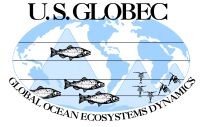August 17, 2002
Final run of the mesoscale survey8:30 a.m.: The
Revelle is moving up the coast near Florence this morning in heavy
fog. The ship is near the eastern end of line four on the
mesoscale survey. On this line the Revelle will be traveling west
far enough get a complete cross section of the flow around Heceta Bank
(see graphic below).
.gif) .jpg) .jpg)
Chief Scientist report 17 August 2002
Quick report from the Revelle before we turn west for a long (~15
hours)
tow along line 4 (Heceta Head) during which we'll lose satellite
communications. The satellite dish is on the starboard side of the
ship's
mast so is blocked from the satellite which is located on the dateline
(180W) above the equator.
We found the bio-optical drifters in the middle of line 8 off Cape
Blanco
after only diverting about a mile from our track line. The drifters
finally got caught up in a strong southward jet (45 cm/s or about 1
knot
of current) and shot down to our track line. Again, a bit of luck
getting
the place and time about right. Line 8 is the Coquille Bank line. We
did
1.5-2 hours of station work near the drifters before redeploying
SeaSoar
and finishing a tow on line 8 to the east. The one sacrifice was loss
of
bird and mammal observations from 125 5'W to the beach, since darkness
set
in as we resumed our tow. Perhaps New Horizon can provide some
anecdotal
reports of mammal activity on line 8. We flew by New Horizon at 124
50'
as they concluded a MOCNESS tow.
Each of our SeaSoar/ADCP/HTI sections across the equatorward jet
continues
to show lots of vertical structure, including alternating layers of
cold
and warm water. High chlorophyll is found in the warm lenses extending
down the isopycnals (lines of constant density) just offshore of the
front
and jet. This is all consistent with a vigorous mesoscale circulation
consisting of jets, meanders and eddies.
We'll conduct another fly-by of New Horizon near HH-5 on the outside
of
Heceta Bank. I'll call Bill on New Horizon via VHF radio when we have
a
firm ETA. Then we'll go offshore to at least 126 30' W to see how far
out
the coastal jet goes around Heceta Bank. Then it's off to the Newport
Hydrographic Line (Line 1), starting at least at NH-65 (125 36'W). We
don't have time to do deep CTDs at these stations, but I'm considering
deploying XBTs (eXpendable BathyThermographs - they measure
temperature
through the water column down to 1000 m) at the deep NH stations.
We'll recover the SeaSoar in the early hours of Monday 8/19 with an
ETA at
the whistle buoy at 0630 and at the dock at 0730.
---Jack Barth, Chief Scientist R/V Roger Revelle
filed 0945 PDT August 17 2002
3:00 p.m.: The New Horizon was spotted at 3:00 p.m. at 125
01'W under clear skies. The bird and mammal observation team
were taking advantage of the chance to be out on deck without the fog
horn running as it was earlier in the morning. The Revelle will
continue on SeaSoaring to the east.
.jpg) .jpg) .jpg) .jpg)
8:00 p.m.: The Revelle travelled on through the
night all the way to 127 W, about 120 nautical miles or 138 statute
miles off the coast. Early in the morning the ship will be
moving north to the west end of line one, the Newport hydrographic
line.
.jpg)
Previous update August 16
Next update August 18 |


.gif)
.jpg)
.jpg)
.jpg)
.jpg)
.jpg)
.jpg)
.jpg)

